Belle Isle
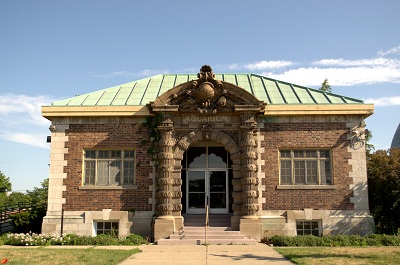
Belle Isle is a Detroit gem. The 982-acre island in the Detroit River is a favorite for many. The beautiful island park - that is also the largest island city park in the United States - is managed by the Detroit Recreation Department. One gets to Belle Isle via the MacArthur Bridge. The island is home to the Anna Scripps Whitcomb Conservatory, the Detroit Yacht Club, the Detroit Boat Club, the James Scott Memorial Fountain and a United States Coast Guard station, among other attractions.
Settled by French colonists in the eighteenth century, it was originally named Île aux Cochons (Hog Island). The modern name, given in 1845, was in honor of the Count of Belle Isle, whom was physician to Antoine de la Mothe Cadillac. The design of the island was created in the 1880s by Frederick Law Olmsted. He was a prominent urban park designer. The casino on the island, the Belle Isle Casino, is in fact not a casino and is sometimes used for public events. Today, Belle Isle is still visited by thousands and thousands each year, and has recently hosted the Detroit Indy Grand Prix.
Campus Martius Park
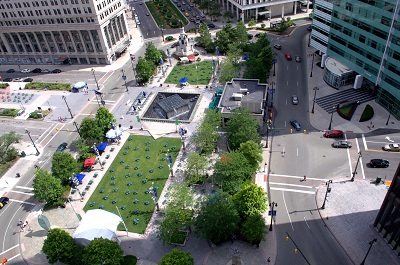
Campus Martius Park, also known as Detroit's Gathering Place, is one of the most beautiful parks in the world, and is located at the heart of downtown Detroit. The park has become the signature downtown area. It is visited by many throughout the city, as well as visitors to the city. The idea of the park was put forth by Detroit Mayor Dennis W. Archer. He wanted it to be the best space in the world. The organization Detroit 300, Inc. took the project of creating Campus Martius under their wing. The Mayor and Detroit 300 put together a task force including many public and private sector leaders. Some of those on the task force were Compuware Chairman Peter Karmanos, the Kern Woodward Associates, and City Council members, among others.
Campus Martius was a drill ground for military training in 1788. The name of the park is after Campus Martius at Marietta, Ohio, and means "military ground". Judge Woodward was appointed, in 1805, to oversee the layout of the city. He gathered many from Canada, and they placed devices at what is now the Point of Origin to figure out true North.
Foxtown
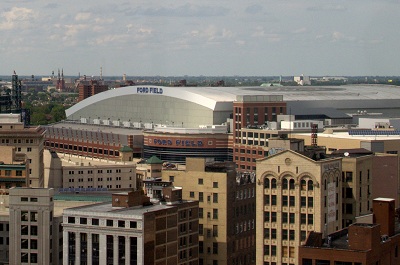
While there is entertainment throughout all of Detroit, the largest attractions are located in a couple block radius known as Foxtown. Comerica Park, Ford Field, Fox Theatre, The Fillmore, and many bars and restaurants are in this area. If you want to grab a concert, or attend a game, this is your place.
The oldest of the four main attractions in this area is the Fillmore Detroit. Ford Field was built in 2002, Comerica Park was built in 2000, and the Fox Theatre in 1928. The Fillmore Detroit - formerly the State Theatre - was built in 1925.
Although The Fillmore Detroit is a little older than the Fox Theatre, more are probably familiar with the Fox Theatre. It was originally part of the Fox Theatres movie chain and its claim to fame is that it was the first built to contain a speaker system for sound films. In 1985 it was added to the National Register of Historic Places and was designated a National Historic Landmark in 1989.
Greektown
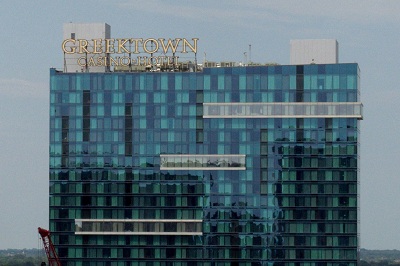
Greektown is a great place to hang out in Detroit. If you are a fan of Greek food, culture or architecture, be sure not to miss this area of town. One can reach Greektown via the People Mover on Beaubien Street.
The area was originally founded by German settlers in the 1830s. The Second Baptist Church, found on Monroe Avenue, is the oldest African-American church in the Midwestern United States. It was founded by thirteen former slaves and became a safe house as part of the Underground Railroad. Over 5,000 slaves passed through this station en route to Canada.
Due to the Greeks moving out, Detroit threw a parade in 1966 that attracted many and coincided with Fourth of July celebrations - Greektown was now established in Detroit.
In March in Greektown, there is a Greek Independence Day Parade. The parade is attended by over 5,000 each year and is hosted by the Detroit Greek Independence Day Committee and started during World War II. In 1982, Greektown was added to the National Register of Historic Places.
RiverFront
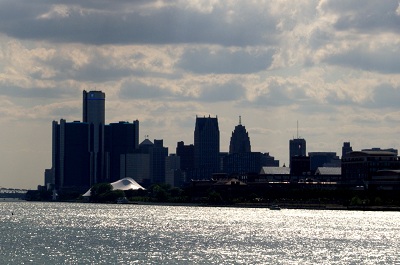
The Detroit International RiverFront is a beautiful area. It is home to Hart Plaza, and the Chene Park amphitheater that seats over six thousand. One can enjoy the five and a half miles of the RiverFront on the Detroit River and the skyline of Windsor while walking the RiverFront.
Recently, in 2010, Detroit added the Port Authority to the RiverFront. This was a nice addition to the beautiful RiverFront. The Detroit RiverFront Conservancy, the organization responsible for the RiverFront, has plans for the three and a half miles east of Hart Plaza that stretches to Joe Louis Arena.
Some events held on the RiverFront are The Detroit-Windsor Freedom Festival, The Detroit Electronic Music Festival, and the Detroit International Jazz Festival.
Wayne State University
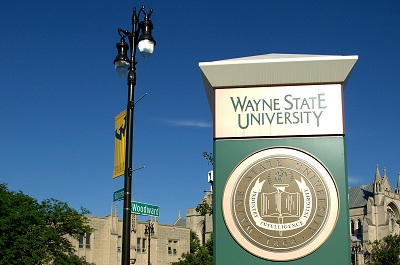
Wayne State University is the only public university in Detroit, and is world-class. It offers more than 400 academic programs and has thirteen schools and colleges. Nearly 32,000 attend.
Wayne State University was founded in 1868 and now has more than one hundred buildings. There are also five extensions centers throughout eastern Michigan. WSU boasts the most diverse student body of the public universities in Michigan with students from forty-nine states and sixty countries.
"State" was not always part of the WSU name. The name Wayne University was adopted in 1934, taken from Wayne County and originally from General Anthony Wayne. It was not Wayne State University until 1956 via Act 183 of the Michigan Public Acts of 1956.
